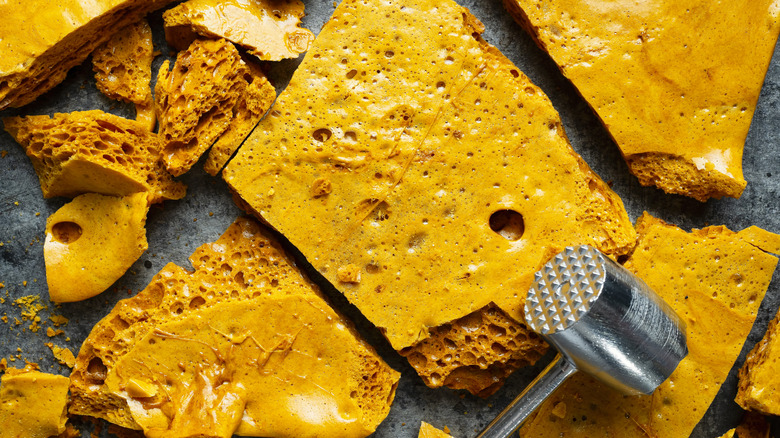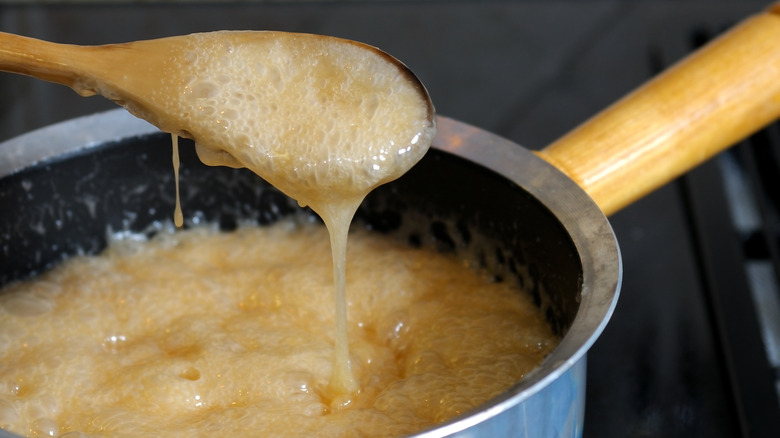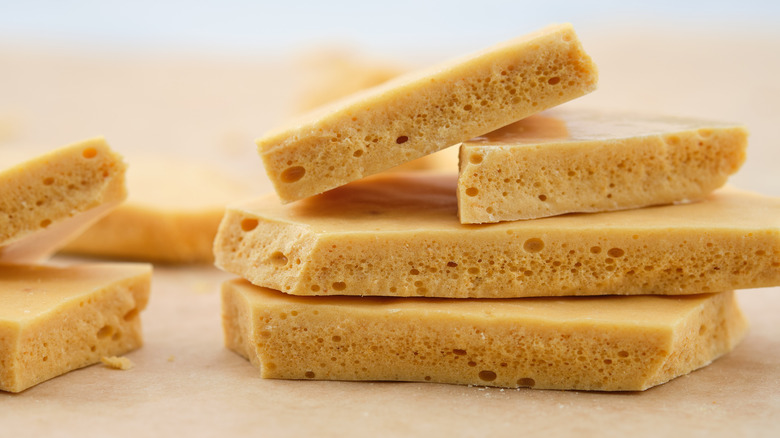The Science Behind Cinder Toffee's Signature Honeycomb Look
Cinder toffee is a confectionery treat that has long been enjoyed traditionally in the U.K. It has a brittle, snappy texture with a golden color and signature bubbles that make it look like a honeycomb. This honeycomb appearance and crisp, airy consistency make it a perfect textural addition when broken up into pieces and incorporated into ice cream — or eaten straight from the palm of your hand as an afternoon sweet.
But how does cinder toffee get its honeycomb nature? It's made using a simple recipe of granulated sugar and syrup, which gets heated. Once molten and heated according to its candy-making specifications, one key ingredient is added to impart the treat's iconic bubbled appearance: baking soda.
In cinder toffee, the baking soda (also known by its chemical name, sodium bicarbonate) interacts with the hot sugary syrup mixture to form air bubbles. The resulting science of the reaction is akin to when baking soda is added as a leavening agent to give baked goods their height. When the baking soda, which has a basic pH, reacts with hot sugar (with a lower, more acidic pH), carbon dioxide gas is produced, and air bubbles are formed and trapped in the sugary matrix, creating cinder toffee's signature honeycomb look and bubbly bite. Key to ensuring the bubbles stay intact is immediately pouring the hot mixture onto a prepared baking sheet and letting it cool to preserve the bubbles as the cinder toffee sets.
A precise candy-making method is key to forming the honeycomb
To make your own homemade honeycomb candy, combine granulated sugar and syrup in a saucepan over low heat to dissolve the sugar, stirring constantly with a wooden spoon. Increase the heat to medium-high, and continue stirring to prevent the sugar from burning. Then, using a candy thermometer, monitor the temperature of the mixture until your sugar and syrup mixture begins to turn golden amber in color and has reached 295 degrees Fahrenheit — or the hard crack stage of candy-making, where the resulting candy is brittle and crisp.
Once this stage is reached, take your pan off the heat and whisk in your baking soda (sifted prior to prevent any lumps) until just incorporated, being careful not to over-whisk, as this could break the formation of bubbles. You'll want to make sure your saucepan is big enough to prevent the syrup from boiling over, as the mixture will bubble and foam once you add the baking soda.
Immediately pour the hot mixture onto a baking sheet prepared with parchment paper to cover all sides. Once your mixture has been poured onto the sheet, there's no need to smooth it over with a spatula, as this will disturb the bubble formation. Leave your cinder toffee to set for about an hour and a half until it's completely cooled and brittle. Break it apart into pieces with your hands or a knife (to work out some frustrations, use a kitchen mallet to break the toffee).
Get creative with your cinder toffee
The preparation method is quite an exact art and science, but once you have the process down, you can make alterations to make your crisp, airy toffee unique. While many recipes call for dark corn syrup or golden syrup (an amber and buttery British kitchen staple of inverted sugar made of sugar, water, and citric acid), you can also use a combination of equal parts honey and water to impart a floral, sweet depth of flavor to your honeycomb with a truly buzzy bite. To impart your own flavor twist, add in vanilla and other extracts or spices — such as dried ginger and a pinch of nutmeg — at the same time you whisk in the baking soda. You can also experiment with different-sized sheet pans or use a loaf pan to find the perfect height for your cinder toffee.
Since cinder toffee can be pretty susceptible to absorbing moisture, store your honeycomb in an airtight container for up to about a week. To extend the time your honeycomb stays crispy and brittle, dip and cover your candy pieces in melted chocolate to make for a delicious moisture barrier. Alternatively, cut your honeycomb into uniform rectangles to craft your own copycat Cadbury Crunchie bars.


